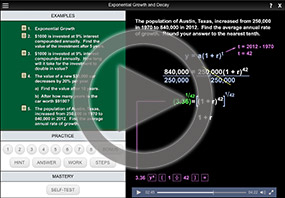Exponential-Growth Word Problems
Purplemath
What is the formula for exponential growth?
Exponential growth word problems work off the exponential-growth formula, A = Pert, where A is the ending amount of whatever you're dealing with (for example, money sitting in an investment, or bacteria growing in a petri dish), P is the beginning amount of that same whatever, r is the growth constant, and t is time.
Content Continues Below
The exponential-growth formula A = Pert is related to the compound-interest formula, and represents the case of the interest being compounded "continuously".
Note that the particular variables used in the equation may change from one problem to another, or from one context to another, but that the structure of the equation is always the same. For instance, all of the following represent the same relationship:
A = Pert
A = Pekt
Q = Nekt
Q = Q0ekt
No matter the particular letters used, the green variable stands for the ending amount, the blue variable stands for the beginning amount, the red variable stands for the growth constant, and the purple variable stands for time. Get comfortable with this formula; you'll be seeing a lot of it.
How do you solve exponential growth problems?
To solve exponential growth word problems, you may be plugging one value into the exponential-growth equation, and solving for the required result. But you may need to solve two problems in one, where you use, say, the doubling-time information to find the growth constant (probably by solving the exponential equation by using logarithms), and then using that value to find whatever the exercise requested.
What is an example of an exponential growth problem?
- A biologist is researching a newly-discovered species of bacteria. At time t = 0 hours, he puts one hundred bacteria into what he has determined to be a favorable growth medium. Six hours later, he measures 450 bacteria. Assuming exponential growth, what is the growth constant k for the bacteria? (Round k to two decimal places.)
Affiliate
For this exercise, the units on time t will be hours, because the growth is being measured in terms of hours.
The beginning amount P is the amount at time t = 0, so, for this problem, P = 100.
The ending amount is A = 450 at t = 6 hours.
The only variable I don't have a value for is the growth constant k, which also happens to be what I'm looking for. So I'll plug all the known values into the exponential-growth formula, and then solve for the growth constant:
A = Pekt
450 = 100e6k
4.5 = e6k
ln(4.5) = 6k
They want me to round my decimal value (found by punching keys on my calculator) to two decimal places. So my answer is:
k = 0.25
Many math classes, math books, and math instructors leave off the units for the growth and decay rates. However, if you see this topic again in chemistry or physics, you will probably be expected to use proper units ("growth-decay constant ÷ time"). If I had included this information in my solution above, my answer would have been "k = 0.25/hour". I doubt that your math class will even mention this, let alone require that you include this. Still, it's not a bad idea to get into the habit now of checking and reporting your units.
Note that the constant was positive, because it was a growth constant. If I had come up with a negative value for the growth constant, then I would have known to check my work to find my error(s).
Content Continues Below
- A certain type of bacteria, given a favorable growth medium, doubles in population every 6.5 hours. Given that there were approximately 100 bacteria to start with, how many bacteria will there be in a day and a half?
In this problem, I know that time t will be in hours, because they gave me growth in terms of hours. As a result, I'll convert "a day and a half" to "thirty-six hours", so my units match.
I know that the starting population is P = 100, and I need to find A at time t = 36.
Advertisement
But what is the growth constant k? And why do they tell me what the doubling time is?
They gave me the doubling time because I can use this to find the growth constant k. Then, once I have this constant, I can go on to answer the actual question.
So this exercise actually has two unknowns, the growth constant k and the ending amount A. I can use the doubling time to find the growth constant, at which point the only remaining value will be the ending amount, which is what they actually asked for. So first I'll find the constant.
If the initial population were, say, 100, then, in 6.5 hours (being the specified doubling time), the population would be 200. (It doesn't matter what starting value I pick for this part of my solution, as long as my ending value is twice as much. It's the "twice as much" that matters here, more than the number that it's twice of.) I'll set this up and solve for k:
A = Pekt
200 = 100e6.5k
2 = e6.5k
At this point, I need to use logs to solve:
ln(2) = 6.5k
I could simplify this to a decimal approximation, but I won't, because I don't want to introduce round-off error if I can avoid it. So, for now, the growth constant will remain this "exact" value. (I might want to check this value quickly in my calculator, to make sure that this growth constant is positive, as it should be. If I have a negative value at this stage, I need to go back and check my work.)
Now that I have the growth constant, I can answer the actual question, which was "How many bacteria will there be in thirty-six hours?" This means using 100 for P, 36 for t, and the above expression for k. I plug these values into the formula, and then I simplify to find A:
A = 100e36(ln(2)/6.5) = 4647.75313957...
I will take the luxury of assuming that they don't want fractional bacteria (being the 0.7313957... part), so I'll round to the nearest whole number.
about 4648 bacteria
Affiliate
You can do a rough check of this answer, using the fact that exponential processes involve doubling times. The doubling time in this case is 6.5 hours, or between 6 and 7 hours.
If the bacteria doubled every six hours, then there would be 200 in six hours, 400 in twelve hours, 800 in eighteen hours, 1600 in twenty-four hours, 3200 in thirty hours, and 6400 in thirty-six hours.
If the bacteria doubled every seven hours, then there would be 200 in seven hours, 400 in fourteen hours, 800 in twenty-one hours, 1600 in twenty-eight hours, and 3200 in thirty-five hours.
The answer I got above, 4678 bacteria in thirty-six hours, fits nicely between these two estimates.
Warning: When doing the above simplification of , try to do the calculations completely within your calculator in order to avoid round-off error. It is best to work from the inside out, starting with the exponent, then the exponential, and finally the multiplication, like this:

Note: When you are given a nice, neat doubling time, another method for solving the exercise is to use a base of 2. First, figure out how many doubling-times that you've been given. In the above case, this would start by noting that "a day and a half" is 36 hours, so we have:
36 ÷ 6.5 = 72/13
Use this as the power on 2:
100 × 2(72/13) = 4647.75314...
Not all algebra classes cover this method. If you're required to use the first method for every exercise of this type, then do so (in order to get the full points). Otherwise, this base-2 trick can be a time-saver. And, yes, you'd use a base of 3 if you'd been given a tripling-time, a base of 4 for a quadrupling-time, etc.
URL: https://www.purplemath.com/modules/expoprob2.htm.htm
Select a Course Below
Standardized Test Prep
Homeschool Math
© 2024 Purplemath, Inc. All right reserved. Web Design by ![]()




